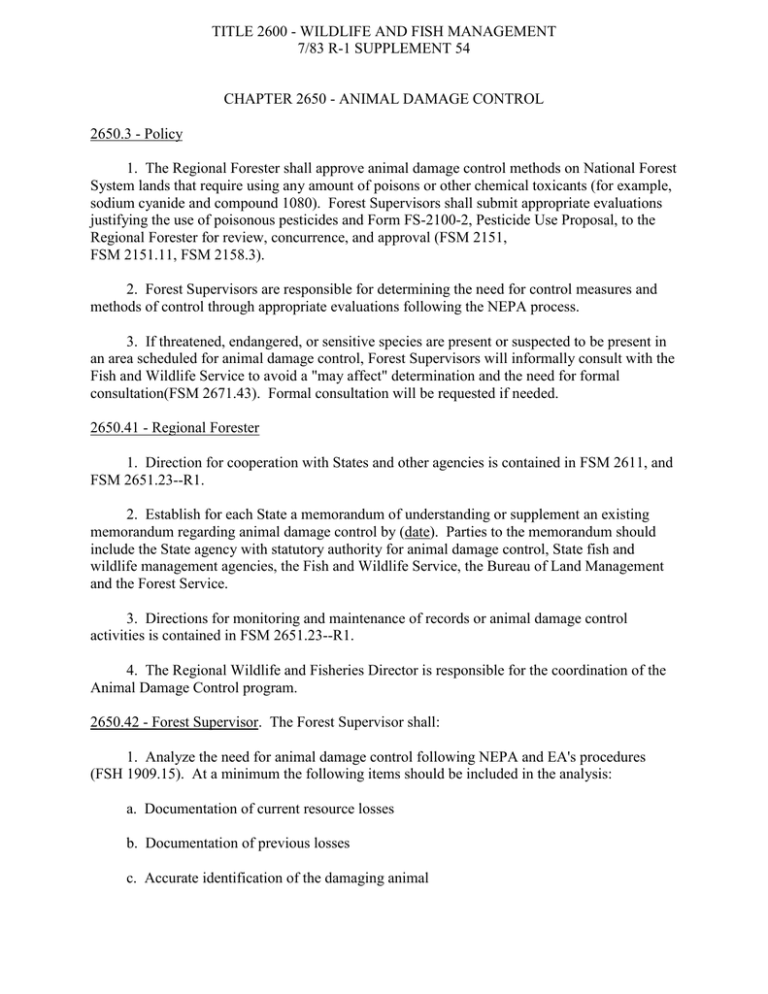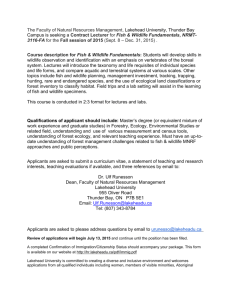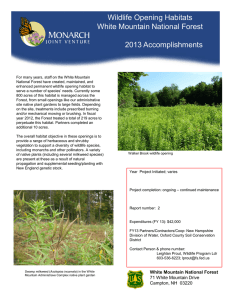TITLE 2600 - WILDLIFE AND FISH MANAGEMENT 7/83 R-1 SUPPLEMENT 54
advertisement

TITLE 2600 - WILDLIFE AND FISH MANAGEMENT 7/83 R-1 SUPPLEMENT 54 CHAPTER 2650 - ANIMAL DAMAGE CONTROL 2650.3 - Policy 1. The Regional Forester shall approve animal damage control methods on National Forest System lands that require using any amount of poisons or other chemical toxicants (for example, sodium cyanide and compound 1080). Forest Supervisors shall submit appropriate evaluations justifying the use of poisonous pesticides and Form FS-2100-2, Pesticide Use Proposal, to the Regional Forester for review, concurrence, and approval (FSM 2151, FSM 2151.11, FSM 2158.3). 2. Forest Supervisors are responsible for determining the need for control measures and methods of control through appropriate evaluations following the NEPA process. 3. If threatened, endangered, or sensitive species are present or suspected to be present in an area scheduled for animal damage control, Forest Supervisors will informally consult with the Fish and Wildlife Service to avoid a "may affect" determination and the need for formal consultation(FSM 2671.43). Formal consultation will be requested if needed. 2650.41 - Regional Forester 1. Direction for cooperation with States and other agencies is contained in FSM 2611, and FSM 2651.23--R1. 2. Establish for each State a memorandum of understanding or supplement an existing memorandum regarding animal damage control by (date). Parties to the memorandum should include the State agency with statutory authority for animal damage control, State fish and wildlife management agencies, the Fish and Wildlife Service, the Bureau of Land Management and the Forest Service. 3. Directions for monitoring and maintenance of records or animal damage control activities is contained in FSM 2651.23--R1. 4. The Regional Wildlife and Fisheries Director is responsible for the coordination of the Animal Damage Control program. 2650.42 - Forest Supervisor. The Forest Supervisor shall: 1. Analyze the need for animal damage control following NEPA and EA's procedures (FSH 1909.15). At a minimum the following items should be included in the analysis: a. Documentation of current resource losses b. Documentation of previous losses c. Accurate identification of the damaging animal d. Target and non-target species affected e. Threatened and endangered species f. Methods and timing of control activities g. Area to be treated h. Precautions to be taken 2. In addition to consulting with State fish and wildlife agencies and the Fish and Wildlife Service, Forest Supervisors shall also consult the State agency with statutory authority for animal damage control (for example, the Montana Department of Agriculture). 2651 - Wildlife Populations Control 2651.1 - Game Animals. Control of game animals and fish shall be accomplished only through the cooperation of the regulatory State agencies concerned (2643). 2651.2 - Predator Control Animal Damage Control 2651.23 - Procedures 1. Requests for Animal Damage Control. The Forest Service is by authority the lead agency to receive requests for animal damage control on National Forest System lands. However, the ranching community has traditionally made such requets directly to the Fish and Wildlife Service or to the State agency with animal damage control authority and will likely continue to do so. Therefore, in the memorandum of understanding on animal damage control the Fish and Wildlife Service and the responsible State agency agree with the Forest Service to promptly forward copies of all requests to the Forest Supervisor. The Fish and Wildlife Service will continue to initiate control action as specified in the annual work plan. If a request comes directly to the Forest, the Forest Supervisor will forward a copy to the Fish and Wildlife Service and to the State agency responsible for animal damage control. Provisions for handling emergency requests for animal damage control should be addressed in The Memorandum of Understanding (FSM 2650.41(2)--R1) and animal damage control work plan and reviewed annually at the meeting on animal damage control. 2. Cooperation with States and Other Agencies a. Meetings (1) Each Forest meeting animal damage control will meet annually prior to the operating season with representatives of State and other Federal agencies to review, update, and agree upon the animal damage control work-plan for the following year. Several Forests may wish to plan a joint meeting (as appropriate) to reduce time demands on personnel from all agencies. (2) Attendees at this meeting should include at a minimum one representative from each Forest involved, the Fish and Wildlife Service, State fish and wildlife management agencies, the State agency with statutory authority for animal damage control, and the Bureau of Land Management (if appropriate). b. Animal damage control annual work-plans for those Forests with animal damage needs will include: (1) Maps. (a) Each Forest will prepare a map identifying areas where control is permitted; is not permitted; or is not planned but will be allowed if approved by the Forest Supervisor. Control measures in areas of human concentrations (e.g. developed campgrounds) are not permitted except when an animal or animals become a threat to human health or safety. (b) For each area where control measures are permitted: - Identify the type of control activity and methods tht are/are not permitted. - Specify when control measures will be permitted. Consider recreational use, season of wildlife use (e.g. winter ranges), livestock grazing activity, and sport hunting. (2) Requests for Control Action. Individual requests for animal damage control will specify at least the following: (a) Area to be treated (b) Desired time period for treatment (c) Control methods: equipment, materials, number of sites or applications, etc. (d) Current resource losses (e) History of resource losses (f) Responsible animal (3) The Forest Supervisor's analysis, evaluation, determination of need, and approval. 2652 - Records 2652.1 - Records (and monitoring) 1. Use of any chemical toxicant will be recorded on the Pesticide-Use Report, Form FS2100-1 (FSM 2158.2). 2. Animal damage control activities will be reported in the Annual Wildlife Report (FSM 2663) 3. Effectiveness of animal damage control activities can be monitored through accurate record keeping and reporting accomplishments of control activities. a. Each Forest should maintain files on: (1) Control requests (2) Approved control requests (3) Control activities carried out b. For each control project or activity carried out the Fish and Wildlife Service, the responsible State agency, or others authorized to control activities shall report the following information to the appropriate Forest (this information is included on Fish and Wildlife Service ADC Form No. R2-208): (1) Area treated (2) Target species (3) Number of target species taken (4) Kind and number of non-target species taken (5) Control methods (a) Activity (baiting, poisoning, trapping, gunning, aerial gunning) (b) Number of stations (6) Time period. If aircraft is used, indicate type of aircraft and number of hours flown. (7) Estimate of total expenses to include salaries, equipment, and materials. (8) Economic value of resources lost.

